|
Around mid-December, a friend posed this question on Facebook: What’s something that you thought you’d do this year during your changed world due to the pandemic, but turns out you didn’t do?  Did you plan to learn tai chi during the past year's downtime? Did you plan to learn tai chi during the past year's downtime? She got things rolling with her own confession that she’d intended to learn and practice tai chi using a DVD that had been recommended, but after trying it couple times, she never returned to the practice.  Was baking bread on your pandemic project list? Was baking bread on your pandemic project list? In the comments under her post, a few other people said they’d planned to learn something new—a language or a skill like baking bread—or spend more time doing something they already enjoyed, like painting. Or something they perhaps didn’t enjoy so much—working out, for instance—but resolved to do. Yet even in their changed worlds, days filled up with routine tasks like bill-paying, yard work, and household chores, on top of which some had the added responsibility of teaching homebound children. Then there were those who were sure they’d use their extra home-time to finally get organized. Garages, closets, storerooms all would be neat and orderly by the end of 2020. That didn’t always happen, either. Turns out those tasks are no less tedious when you have time for them than when you’re occupied with other things. I made that discovery myself. After an initial blitz of cleaning out cabinets, drawers, and closets, culling stuff, stuff, and more stuff, I hit a wall. Or maybe it was that warm weather arrived, and outdoor projects had more appeal.  I made some new paths through the woods, but other outdoor projects remained unfinished I made some new paths through the woods, but other outdoor projects remained unfinished About those outdoor projects: there again, I had big plans for finishing the landscaping we’ve been trying over the past few summers to complete. I did make progress, but finish? Nope. Maybe next summer. What about you? What became of your intentions for 2020? What got done, and what got left undone? Does the answer to that question reflect a shift in priorities, or merely an adjustment to reality? 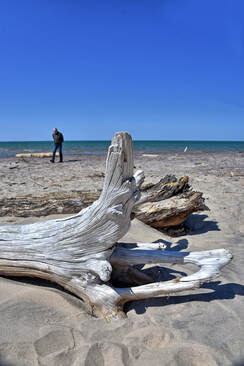 Some days, an excursion to Lake Michigan mattered more than getting things done Some days, an excursion to Lake Michigan mattered more than getting things done My answer to that last question is, a little of both. Working on my novel-in-progress became a higher priority than cleaning out every last file drawer. Organizing Zoom readings of my memoir took precedence over reorganizing my wardrobe. And some days, watching movies, playing Scrabble, or going for a long drive with Ray—compensating for the concerts, readings, and other live events we could no longer attend—felt more important than accomplishing anything at all. Now, a new year lies ahead, but life isn’t likely to return to normal (whatever form that takes) for at least another few months. So how to spend the remainder of our reconfigured time? Tackle more tasks or take advantage of these more spacious days to let our imaginations wander and our creative impulses reign? I gave some thought to that question as 2020 wound down. While I had no trouble coming up with lists of household projects to finish and other business to take care of, I realized my choices for the past year pointed to the way forward for the next. The things that yielded satisfaction—writing and other creative work, keeping in touch with friends, spending time with Ray—are the things I want to devote the most time and energy to. Not that I’ll ignore the rest. Checking off mundane tasks brings its own kind of satisfaction. But this time next year, I have a feeling the number of chores I’ve crossed off won’t matter nearly as much as the kind of contentment that comes from creativity and connection. (Oh, hey, that sounds like a catchy tagline for a blog!)
10 Comments
Last week I got back to work on my novel-in-progress after taking several weeks off to focus on other matters. There’s been some stuff going on, ya know? There still is, but at least I’m able to inhabit islands of concentration here and there. Of course, it always takes time to get up to speed on something you’ve set aside, and that’s especially true in this case because I’m using a completely different (for me) approach with this writing project—one that requires a great deal of thought and patience.  In my novel project, I'm using the method detailed in this book In my novel project, I'm using the method detailed in this book As I ease back into this painstaking process, I can’t help thinking it might serve as a model for how to approach life in general. I’ll elaborate on that in a moment, but first a little more about the writing part. The method I’m following was developed by author Lisa Cron and detailed in her 2016 book Story Genius: How to Use Brain Science to Go Beyond Outlining and Write a Riveting Novel (Before You Waste Three Years Writing 327 Pages That Go Nowhere). What aspiring author wouldn’t be seduced by that title? Shave three years off the process and end up with a riveting novel? Sign me up!  Cron advocates the use of scene cards such as this one to "blueprint" your novel, scene by scene. Cron advocates the use of scene cards such as this one to "blueprint" your novel, scene by scene. But it turns out the secret isn’t to power through, wildly racking up word counts. It’s to carefully “blueprint” every single scene, stifling the impulse to start writing the scene until you’ve answered several key questions. And I mean really answered them thoroughly, sometimes with pages of brainstorming ideas that will never make it into the manuscript. Questions such as:
Whew! See what I mean about a lot to think about? All this could easily be overwhelming if you had to lay out the whole novel, scene by scene, before writing a single word. But it doesn’t work that way. You draft an opening scene—realizing it’s only a draft that will be revised many times—and an ending scene, again knowing it, too, will likely change. Then you methodically fill the space between beginning and end, working in chunks of scenes. Map out a chunk, blueprinting scene by scene. Write those scenes. Then blueprint another chunk of scenes, one at a time, and write those. From time to time, spiral back to the scenes you’ve already written, and layer in new information, new setups and storylines that emerge as you go, always keeping the end in sight. Now, how does this apply to life in general? Obviously we can’t spiral back and rewrite parts of our lives, much as we might wish we could! Still, I do see a few parallels. The first is that in the Story Genius method, the focus is on each scene. Instead of getting overwhelmed by the idea of writing a whole novel, you zero in on the scene in front of you, examine it from several angles, and think it through before moving on. Kind of like focusing on what’s happening right here, right now, each day instead of letting your mind get stuck in the “If only . . .” of your past or fast-forwarding into the “What if . . .?” of the future. The idea isn’t to over-analyze each moment, but to be aware and focused on the here and now. Second, just as writers following Story Genius ask what their characters believe and why, we all can benefit from examining our beliefs and motivations. Where do they come from, and how trustworthy are those sources? How do our beliefs affect our worldview, and how do our experiences change them? Finally, unlike authors of novels, we can’t predict how our own stories will end. But we can keep in mind our ultimate goals and intentions and try to make sure every scene in our saga unfolds in a way that leads us in the direction we want to go. So, there was a presidential election yesterday, right? Yet as of this morning, we don't know the outcome, and we may not know for some time. What to do until then (besides nail-biting and obsessively checking the news)? Let's all take a deep breath and enjoy another visual retreat with some of my favorite photos from the past four months. The last installment of HeartWood—the story of a young writer’s devotion to his grandmother and her literary legacy—got me thinking about other stories of art and devotion, which took me back to a trip to Albuquerque three years ago. 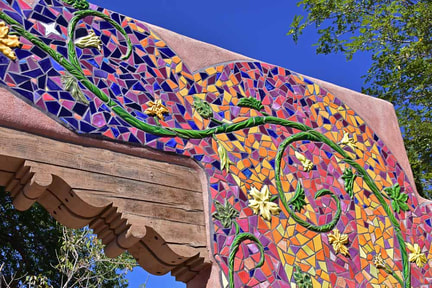 Mosaic in Albuquerque's Old Town Mosaic in Albuquerque's Old Town Albuquerque, nearby Santa Fe, and their surroundings are spilling over with creative people whose devotion to their art is evident. Painters, sculptors, mosaic artists, multi-media creators, jewelry designers—they're everywhere, and so are the fruits of their talents.  Promoting the Santero Market Promoting the Santero Market Evident, too, are signs of a different kind of devotion: works of art inspired by spirituality and religious faith. I learned about one type of this art from two women I chanced to meet on a Sunday morning in Albuquerque's Old Town. Felis Armijo and Ramona Garcia-Lovato were sitting at a table in front of San Felipe de Neri Church, signing up volunteers to help with the upcoming Santero Market. Santeros (and santeras) are artisans who craft religious icons called santos. Originally created for churches, these statuettes of saints, angels, Mary and Jesus, usually carved from wood and often decorated with home-made pigments, are now sold to tourists. 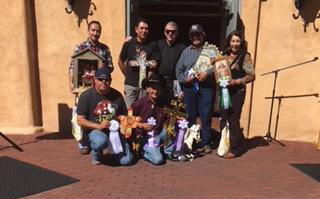 My conversation with Felis and Ramona rambled from topic to topic, touching not only on art, but also on writing, life stories, geography, and human nature. From their curiosity and warmth, it was clear these two women were dedicated not just to the event they were promoting and the parish to which they belonged, but also to connecting with other people—an art in itself. 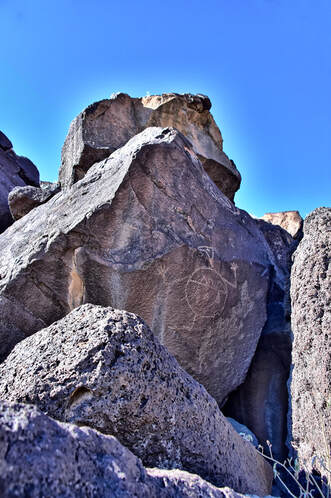 Petroglyph Petroglyph After our time in Old Town, Ray and I ventured out to Petroglyph National Monument, a short drive away. One of the largest petroglyph sites in North America, the monument features designs and symbols carved onto the surfaces of volcanic rocks by indigenous people and Spanish settlers 400 to 700 years ago. The site and its images still hold spiritual significance for the descendants of both groups of people.  Significant symbols Significant symbols The meanings of some symbols have been lost over the centuries; others are known by a few indigenous groups, but it is considered culturally insensitive to reveal the meaning of an image to others. For me, it's enough to know that the symbols meant something to the people who created them and to ponder the combination of location and inspiration that gave rise to their work.  Larry Schulte Larry Schulte Not all works of devotion have religious significance. They also can be inspired by a more secular kind of admiration. Case in point: my friend Larry Schulte, an artist who now lives in Albuquerque, created his own "Saints" series, featuring mortals who have made a difference in his life. “I was raised in a fairly strict Roman Catholic home, and I left that faith many years ago—mostly because of their stance on gay people, that we were sinful,” Larry reflects. “These saints in some way replace the saints I learned about in my childhood . . . They are all loving, sharing people who have made my world a better place. We all need something to believe in. For me it is love, art/creating, and people, rather than any organized religion.”  St. Lou St. Lou Some of the fifteen mixed media pieces, which Larry created at the Ragdale Foundation, an artist's colony north of Chicago, feature well-known figures—such as the innovative composer Lou Harrison and Harrison's life partner Bill Colvig, an instrument builder who collaborated with Harrison on gamelans and other percussion instruments. But they also include more personal choices: Larry’s undergraduate art instructors, St. Jack and St. Keith, for instance. “Jack was particularly influential in my pursuing art,” Larry recalls.  St. Elvira St. Elvira St. Elvira’s son Peter was Larry’s roommate and best friend during their days at the University of Kansas in the late 1970s to early 1980s. Elvira lived in New Jersey but had visited Peter and Larry in Kansas. “After I moved to New York City, she included me in holiday family gatherings when I wasn't able to get back to my own family in Nebraska. She adopted me as another son.”  St. Bill St. Bill In 2016, Larry and his partner Alan Zimmerman, a percussionist, traveled to San Francisco for a concert of Harrison's music to celebrate what would have been his 100th birthday. Two of Larry's art works (St. Lou and St. Bill) were exhibited at the concert, which was sponsored by the non-profit organization Other Minds.
If April is the cruelest month, as T.S. Eliot contended, then July must be the friendliest. At least ten countries celebrate Friendship Day in July: Argentina, Bolivia, Brazil, Ecuador, Mexico, Nepal, Pakistan, Spain, Uruguay, and Venezuela. What better time, then, to commemorate a 33-year testament to an even longer friendship?  The way we were -- as thirty-somethings The way we were -- as thirty-somethings This particular tradition began in 1987, when I bought a blank book and wrote an entry in it for my friend Cindi’s birthday, promising to add another entry every year. With the exception of a few years that I somehow let slide by, I’ve kept my word, documenting the ups and downs of our lives—often eerily parallel—and our passage from thirty-somethings to senior citizens.  Lining up for high school commencement Lining up for high school commencement Our friendship goes back even further. My first recollections of Cindi are from fifth grade, when we were in different classes but sometimes hung out together on the playground. We got to know each other better in junior high and were best of friends by high school, when we spent countless hours cruising the Sonic together. When I moved away to Samoa, Cindi saved my letters, which proved invaluable in writing my memoir Mango Rash: Coming of Age in the Land of Frangipani and Fanta. In college, we were protest and peace-march buddies.  Younger days Younger days Then we moved to different parts of the country: Cindi to Texas, me to California, then Kansas and Michigan. Yet we never lost touch, continuing to exchange letters and phone calls, then transitioning to email, and visiting each other when we could. In time, our interests and political leanings diverged. Quite a bit. I wouldn’t say we’re on opposite ends of the spectrum now—we still agree on many issues—but we do have distinct differences. Once that became apparent, though, we made a conscious decision not to let those differences undermine our friendship.  1994 meet-up in Toronto, where we started the tradition of trying to find backdrops that attested to our (real or imagined) gorgeousness 1994 meet-up in Toronto, where we started the tradition of trying to find backdrops that attested to our (real or imagined) gorgeousness Fortunately, one thing we’ll always have in common is our offbeat sense of humor. That, and the birthday book—along with cards, calls, and emails—continue to cement our bond. Every year, Cindi mails the book back to me, and every year I write my entry—sometimes adding a photo of the two of us together, if we’ve managed a rendezvous that year—before mailing the book back. After all these years, the cloth cover, decorated with pressed flowers, has begun to fray. I guess that’s to be expected. We’re not quite as fresh as we were thirty-three years ago, either (though we like the think we are).  A decade later, in another "beautiful" setting. Corpus Christi, Texas, 2004 A decade later, in another "beautiful" setting. Corpus Christi, Texas, 2004 As memories have filled the book, and it’s become more precious to both of us, we’ve wondered if mailing it back and forth might be too risky, if maybe I should find a different way of adding entries. That thought crossed my mind this year as I put the book in the mail a few weeks ago, intending for it to reach Cindi in plenty of time for her June birthday. And then—oh, no—it happened. Due to a post office snafu so byzantine it would take another whole blog post to detail, the book was lost in the mail. Not only did it not arrive in time for Cindi’s birthday, it went missing without tracking information, so there was no way of finding out where it had gone. We consoled ourselves with the knowledge we’d both made photocopies of the pages. Cindi wasn’t sure where she’d put hers, but I was pretty sure I’d made a copy just last year and put it in a file under her name. Sure enough, I found the copy in the file, only to discover I hadn’t made it last year, I’d made it nine years ago. Now, as we wait for the book to show up—and we have to believe it will show up—I look back at pictures from all those years and re-read the entries I managed to save and know that, book or no book, we’ll always have something worth celebrating.
 Jigsaw puzzles: among the new ways of entertaining ourselves Jigsaw puzzles: among the new ways of entertaining ourselves In recent months, we’ve all had to adapt in ways we never expected: new ways of shopping, socializing, working, entertaining ourselves (jigsaw puzzles, anyone?). With Ray and me both retired, the changes weren’t as drastic for us as for many people. While there have been challenges, our adjustment has been relatively smooth, for which I’m grateful. But this home-centered span of time has also shown me how un-adaptable I am in other parts of my life and how I’ve been holding onto expectations that don’t square with reality.  Take my activity patterns, for example. For most of my life, I was an early riser. During my working years, both as an employee and as a freelancer, I usually got up at 5 a.m. and started work at 7:30 or 8:00. For a while after I retired I continued waking up and getting out of bed by 5:00 or 6:00, whether I wanted to or not. I seemed to be hard-wired to get up and get going early. In the past year or so, though, I’ve started sleeping till 7:00, 7:30, and sometimes even later. I feel like I need the sleep, like my body demands it, especially if I’ve done something intensely physical the day before, like a long hike or hours of outdoor work.  I am not a slug! (Photo: Peter Stevens) I am not a slug! (Photo: Peter Stevens) Yet every time I get up later than 6:00, I scold myself for being such a slug, and I still try to keep to a routine that’s based on getting up earlier: meditating and doing yoga before breakfast, then making and eating breakfast, doing some reading over breakfast, cleaning up my dishes and myself, getting dressed, making the bed, doing whatever else needs doing, like taking out the mail, and still being ready to start the day’s main activities (writing and book promotion in the morning; chores, errands, and recreation in the afternoon) by 8:30 or so. So every day starts with this ridiculous and totally unnecessary tension about keeping to a ridiculous and totally unrealistic schedule.  Yoga: First thing in the morning? Or not. Yoga: First thing in the morning? Or not. I’ve experimented with various alternatives—putting off yoga until later in the day, meditating before bed instead of first thing in the morning, streamlining this or that. But I’m starting to see the problem isn’t with the routines themselves, it’s with my attitude toward them. So what if some mornings I get a late start and only have time to write for half an hour instead of an hour or two? Maybe I’ll make up for it another day. And if not, so what? Yes, I feel better on days when I write and I feel off-kilter when I don’t—writing is my happy pill, after all. And yes, I get great satisfaction from seeing the word count and page count increase by the day. But if the world comes to an end, I doubt it will be because I wrote 100 words today instead of 1,000.  Ahhh, the luxury Ahhh, the luxury My reality has shifted, and it’s high time to adapt to the new one instead of clinging to the old one. The truth is, I’ll probably never again routinely get up at 5:00. So why not try to see my sleeping-later habit for what it is—a response to a physical need, not a sign of sloth--and just enjoy the luxury of being able to structure my days around it. Which brings me to another realization about reality. Structure is something else I sometimes feel conflicted about. As I wrote in a 2016 blog post, we all have our own tolerance levels for chaos and structure, and finding the right balance between them is crucial for creativity.  Structure provides a bit of certainty in uncertain times Structure provides a bit of certainty in uncertain times As I’ve been examining how to adjust my usual routines to my unpredictable sleep patterns, I’ve questioned whether I still need a routine at all. After all, I’m retired. Most of the things on my to-do list are want-to-dos, not have-to-dos. Why not just do what I feel like when I feel like it? I’ve thought a lot about that lately, and I’ve come to this conclusion: There may be a time to ditch my routines, but this isn’t it. Experts say having consistent daily and weekly routines gives us a sense of certainty in these uncertain times. The trick is to make your days consistent, with enough variety to keep boredom at bay. Sounds like exactly what I’m aiming for as I try to adapt to new realities. I’ll let you know how that works out.
Have you adapted in any surprising ways over the past months? Have you discovered aspects of your life you can let go of and others you still need to hold onto? If you've been a HeartWood subscriber for a while, you may remember the Last Wednesday Wisdom feature that appeared on the last Wednesday of every month. When I switched to publishing blog posts only twice a month--on the first and third Wednesdays--that feature went away, except for occasional appearances in months with an extra Wednesday. During these troubled times, though, I couldn't think of anything better to offer than a collection of wisdom from other minds. I hope you find comfort and inspiration here. Life is glorious, but life is also wretched. It is both. Appreciating the gloriousness inspires us, encourages us, cheers us up, gives us a bigger perspective, energizes us. We feel connected. But if that's all that's happening, we get arrogant and start to look down on others . . . On the other hand, wretchedness--life's painful aspect--softens us up considerably. . . but if we were only wretched . . . we'd be so depressed, discouraged, and hopeless that we wouldn't have enough energy to eat an apple. Gloriousness and wretchedness need each other. One inspires us, the other softens us. They go together. -- Pema Chödrön You only get one chance. You have one journey through life; you cannot repeat even one moment or retrace one footstep. It seems that we are meant to inhabit and live everything that comes toward us. -- John O'Donohue Prejudice of any kind implies that you are identified with the thinking mind. It means you don't see the other human being anymore, but only your own concept of that human being. To reduce the aliveness of another human being is already a form of violence. -- Eckhart Tolle When you can't find someone to follow, you have to find a way to lead by example. -- Roxane Gay Clouds come floating into my life, no longer to carry rain or usher storm, but to add color to my sunset sky. -- Rabindranath Tagore My sense of the holy . . . is bound up with the hope that someday, any millennium now, my remote descendants will live in a global civilization in which love is pretty much the only law. -- Richard Rorty We have to fight them daily, like fleas, those many small worries about the morrow, for they sap our energies. -- Etty Hillesum You may not control all the events that happen to you, but you can decide not to be reduced by them. -- Maya Angelou You say to yourself when you are at liberty how desperate you are for your solitude, you love your periods of solitude, you scramble for it, you find ways of being by yourself so you can do what you want with yourself and your mind. But when you're deprived of it for a lengthy period then you value human companionship.
-- Wole Soyinka I realize the past couple of months have been anything but a holiday for many people: those who’ve faced illness themselves or cared for ailing family members, those who’ve lost loved ones, others who have lost their jobs or whose professions put them in harm’s way. My heart goes out to all those people and everyone else who has been negatively impacted by COVID-19. I feel fortunate that so far, at least, this time of isolation has been a kind of respite for me. When it all began, back in mid-March, I thought to myself: Well, I always wanted to go on a creativity retreat in some peaceful place. Here’s my chance! And for the most part, that’s how I’ve approached it. Here in our quiet patch of woods, with no outside commitments, I’ve been free to focus on projects I find it hard to concentrate on when I’m always on the go. And a funny thing has happened: The further we get into Stay Home – Stay Safe, the more protective I’ve become of my free time and solitude. Like most people during this time, I’ve been deluged with a mind-boggling number of invitations to Facebook Live events, Zoom gatherings, free webinars, and other virtual happenings. My internet service’s dwindling data allowance won’t permit me to join in most of those, and while I truly regret having to turn down some invitations—especially From the Heart Yoga’s Zoom classes and chats with my yogini sisters—I haven’t minded passing up the rest. They’ve felt like distractions, in the same way that outside commitments often do. So how have I been spending my precious retreat time? Let me count the ways . . . 1. Writing I’ve been working steadily on my novel-in-progress. Rather than spinning out pages, I decided to take a more disciplined approach, guided by the process Lisa Cron champions in her book Story Genius: How to Use Brain Science to Go Beyond Outlining and Write a Riveting Novel (Before You Waste Three Years Writing 327 Pages That Go Nowhere). The title itself was enough to sell me on the book, and as I work my way through it I’m becoming even more of a fan. It’s hard work, requiring a lot of thought and a lot of writing, followed by digging deeper, thinking more, and writing more. Being able to spend hours in concentrated work, not just stolen minutes here and there, has led to much-needed breakthroughs. Finally, I’m getting some clarity on how to achieve what I’m trying to achieve in the story I’m working on. 2. DecoratingEarly in our Newaygo life—around a decade ago—I scoured flea markets, antiques shops, and ebay for interesting picture frames, visualizing a gallery of old family pictures in our upstairs hallway. Those frames have sat in a trunk in the guest bedroom all these years, waiting for me to fill them. Every month of every year I’ve thought I’d get to it, and every month of every year has somehow gotten filled up in other ways. Finally, I gathered frames and photos, did the necessary prep work, and with Ray’s help, hung them in the hall. Here are the pictures that now have homes: While I was at it, I framed a few more of my nature photos to hang in my studio and the guest room. I’m happy seeing the empty spaces filled and even happier having done something that had been on my to-do list far too long. 3. Lending a (Virtual) HandA volunteer opportunity cropped up: entering data for a ballot initiative for which I’d helped gather signatures. I thought, Why not? I certainly have the time! It’s a simple task—just taking names, phone numbers, and email addresses from cell-phone photos of petitions and entering the info onto a spreadsheet. A little hard on the eyes, but easy on the brain, which suits me fine right now. 4. Pathfinding A new path from our back yard into the woods A new path from our back yard into the woods Every spring, one of our tasks is cleaning up downed trees and branches in the patch of woods around our house. Ray cuts up the wood and runs the small and medium-sized pieces through the chipper. I gather up the chips and spread them on the paths we’ve made around our property. This year has yielded enough chips for me to create a new path or two. In the process of making many chip-laden wheelbarrow trips, I rack up an astonishing number of steps, according to my Fitbit. Between that work and my wanderings in the woods (see item #4), I’ve been covering some serious miles.  This patch could be mine! This patch could be mine! Enter the North Country Trail Association’s Hike 100 Challenge. The idea is to hike 100 miles in a year. Normally, those miles have to be on the North Country Trail (though it doesn’t matter whether you hike the same mile 100 times or cover 100 unique miles of trail). But this year, in response to shelter-in-place directives, the association bent the rules to allow all miles walked in April and May—in your backyard, around the house or neighborhood, on the treadmill—to count toward the total. I’ve been keeping track, and I’ve already passed the 60-mile mark. I could very well hit 100 by the end of this month. 5. Woods wanderingTrue, I do this all the time, not just when we’re on lockdown. But spending time in nature has been particularly restorative during this time of unprecedented events and uncertainty. I hauled out my cameras, which I’d been neglecting while busy with book promotion, and discovered anew the joy of wandering around, photographing flowers, flowing water, and woodland creatures. Here are a few shots from my wanderings. You’ll find more at the end of this post. 6. Trying something newI read an article by nature photographer Melissa Groo about an unusual technique for photographing fast-moving birds in flight. Intrigued, I tried it out that very afternoon, trying to catch chickadees and nuthatches coming and going at the bird feeder. While my results aren’t quite where I’d like yet, in terms of sharpness, I was happy to at least capture a complete bird—not just tail feathers at the edge of the frame—on a fair number of attempts. I’m showing you these not because they’re anything to brag about, but because they represent the kind of patient, try-try-again attitude that’s easier to adopt when you’re not trying to fit so many things into your day. 7. Resting and reflectingEmptiness is the pregnant void out of which all creation springs. -- Wayne Muller The above quote is from an article titled “Fear of Rest” in the May issue of The Sun magazine, excerpted from Muller’s book Sabbath: Restoring the Sacred Rhythm of Rest. As so often happens, I came across the article at precisely the time I needed to read it. Musing on the necessity of rest—and our resistance to it—made me more appreciative of having time to intersperse rest with periods of activity. The older I get, the more I respect rest, but I still need reminding sometimes that it’s a legitimate use of time, not only to restore the body, but also to feed creativity. How have the past couple of months been for you? How are you feeling about re-entry? Enjoy a nature break . . .
Even in this strange and uncertain time, we can find reasons to celebrate. Two big reasons come to mind this month.  April is National Poetry Month, and if ever there was a time to read poetry, it’s now, when many of us have extra reading time and are looking to fill our minds with something other than dire news reports.  This month also brings the 50th anniversary of the first Earth Day next Wednesday, April 22. Though the mass celebrations that had been planned will no longer be possible, we can still commemorate the day. Combining these two celebrations, National Poetry Month and Earth Day, I asked local (and not-so-local) poets to contribute Earth Day poems to today’s blog. I’m happy to share those with you now, along with the collage I created for the occasion. As I worked on the collage, I went back and forth in my mind about whether to portray the vision of a healthy Earth that many of us had on the first Earth Day in 1970 or the reality of Earth in 2020. In the end, I opted for the more hopeful vision, because I want to believe there's still hope. Once the piece was done, however, I noticed it's darker than most of my other collages (many of which are now posted on the COLLAGES page on my website). Perhaps in the end, my Earth Day collage reflects both hope and concern, themes you'll find in the poems below. And now, poetry. Sunset Off Brockway |
| This silent green life and death place. Life bursts forth, buzzing around me. Death underfoot- covering the forest floor. Smelling of earthy must and sweet pine. Fallen trees, once promising, now slowly decaying back into Life-giving soil. Life and Death- existing in this shared space. Life and Death, working hand in hand. Life giving into Death giving into Life. |
I Think They Will Not Mind
by Marsha Reeves
I think they will not mind that
wiikaa bi-dagoshinaan.
I arrive late.
Gijiigijigaaneshiiyag gii-giimoodaanagidoowag noopiming
The chickadees were mumbling in the bushes
besho naadazina’iganing.
by the box where I get mail.
Andawendaanaawaa Manaadendamaazowin
They needed an Honor Song
mii wenji-nagamotawagwaa
so I sang to them
nisidawenmangwaa miinawaa
because we understand them again
ezhi-manaadenimangwaa ingiw wiidokawiyangidwaa
the way we respect those who keep us company
gabe biboon
all winter.
Gaawiin da-giizhokoniyesiiwag misawa
They do not need to dress warm and yet
giizhokawiyangidwaa gidode’iminaaning.
they warm our hearts.
* First published on ojibwe.net
Written on the Wind
by Tom Cordle
I stumble in this foreign tongue and try to make the talk
I speak of when this land was young, and of my brother hawk
My spirit voice is hard to hear, I have so long been gone
But I will whisper in your ear, and having spoke, move on
This finger pushed into the sea of sand and swamp and pine
Has been a welcome home to me – I sing this land of mine . .. .
Of night song sung in joyous trill by every kind of fowl . . .
Of chickadee and whippoorwill . . . of warning from the owl . . .
Of plenty fish and wild oats . . . of berries blue and red
That danced their way down happy throats to bellies always fed . . .
Of rivers coursing through green world of gleaming golden lake . . .
Of alligator, hog and squirrel . . . of moccasin the snake . . .
The screaming panther ruled the pine, the eagle ruled the sky –
Oh, will you hear these words of mine? Will you even try?
I have no words on talking leaves for you to read, my friend
For all this simple man believed was written on the wind.
Animal Planet
by Tim Hawkins
and our hearts seek meaning among the stars,
wild creatures assert their presence
in the here and now
and the just here and gone.
Unknowable in the way one speaks
of the alien and other-worldly,
the title to their kingdom is forged
in their absolute
manifestation of the flesh.
If this seems ironic and abstract,
then so be it.
For irony and abstraction
are our great gifts--
not to the world, but to ourselves--
invented for our survival.
And we, of course, are the real aliens;
Each a world unto one’s own,
orbiting a sun of its own devising.
* First published in Sixfold, July 1, 2013, Summer 2013
Collected in Jeremiad Johnson (In Case of Emergency Press, 2019)
Our Mother (In the Pandemic of 2020)
by Sally C. Kane
Do you hear her – Our Great Mother?
In this moment, in time - a reprieve -
when all human activity
has slowed to bare bones minimum,
She inhales an expanse of cleaner air.
Exhales a wasteland of toxins.
Do you hear her – Our Great Mother?
She weeps for us, her children – All
Residents, two-legged and four,
winged, finned and serpentine. We
share the same earth, sea and air.
We, the two-legged ones, hold
the choices in concert with Our Mother.
Even as forces seem out of control, and
the playing field remains unequal.
Do you feel her – Our Great Mother?
She shudders as the sludge venoms
from Frack wells, the vast desolation
from wildfires, and endless wars’ ravages
do a rival dance with the C-virus.
I wonder about this massive
Blue Marble in our universe. The
one we call home. Our Mother.
There’s nowhere else to go. We cannot
just walk off or fly away.
I wonder, if I were an astronaut, or
could hitch a satellite ride, how - in this
Pandemic blink of time –would
Our Mother, our home - look?
Would her greens be greener, her blues
be bluer, her storms less turbulent,
her mass free from veils of smog?
Like a cataclysm, would I see
a rotating orb, vibrating
glimmers of brighter, kinder energy?
Perhaps violet or white? Would
I know – would we all know- we’ve
begun to exercise our choices for love?
Mother's Milk
by Jessica Mondello
Addiction lies between the lines
And love was lost to pride and glory
This ego virus made us blind
Your mother's dying by your hands
But you won't listen
Her blood is all over your hands
Will you listen
The soul was lost beyond the shadows
The fog will choke us into dust
Collective conscience chose the gallows
The time of man will turn the dust
Your mother's dying by your hands
You won't listen
Her blood is all over your hands
Will you listen
The Soul of Spring
by Kathy Misak
I see it in the buds of the maple.
I hear it in the sounds of the red wing black bird.
Inquisitive cat so happy to be playing outside
Warm breeze on the back of my neck
I see it in the new bright yellow feathers of the gold finch.
I hear it in a distant barking dog.
Ever grateful to be walking this Earth mother experiencing my spring soul
And The Earth Stayed Young
by Tom Cordle
And the buffalo could roam
The rivers clear and clean
Washed by our simple homes
And all turned in the wheel
And the sacred song was sung
To teach us what was real
And the earth stayed young
Once a man would take
No more than he could use
Set bones back in the lake
When a meal of fish was through
And all turned in the wheel
And the sacred song was sung
To teach us what was real
And the earth stayed young
Once the earth was young
And men saw with their hearts
That everything was one
And man was but a part
And all turned in the wheel
And the sacred song was sung
To teach us what was real
And the earth stayed young
Now the earth is old
The buffalo are gone
The rivers have been sold
And man stands all alone
Let all turn in the wheel
And sing the sacred song
To teach us what is real
So the earth stays young
What Have You Learned
by Jessica Mondello
That you've all been praying on
That God has only destroyed you
And you can't drink the oil
You've been pulling out of the ground
Your momma's shaken and torn . . . fool
Do you know what you are
And what you're here for
When it all comes crashing down
What have we learned
Distractions have kept you
From what's really going on
Keeping you away from your mother
Her life source you could tap into
Can heal that broken bond
Yes, you can get there inside you
Do you know what you are
And what you're here for
When it comes crashing all down
What have we learned
Pale Blue Seasons
by Tim Hawkins
in the flight of a heron, and to the surrounding
darkness where countless feed.
But so much that is unattainable, so much
that lies beyond the sovereign dark, rises up
out of the pale blue season of twilight
like fireflies summoning among the trees
as the moon loses her translucent and ghostly pallor
in the evening’s first clear and troubling dreams.
***
Toward daylight, the deer rise up
from among the flattened grasses
and low-lying hummocks,
emerging in the cool of morning
from indiscernible swales
and cedar swamps,
wary and shy, but alive with owning
at least a part of this
pale blue season of wildflowers.
* First published in Blueline: June 2011, Volume 32
Collected in Wanderings at Deadline (Aldrich Press, 2012)
 The idea for HeartWood came out of this visit
The idea for HeartWood came out of this visit It all started when he and his husband Steve visited Ray and me here in Newaygo about five years ago. Over lunch at Hit the Road Joe Coffee Café, I groused to John about how authors and would-be authors nowadays can’t just write books, they have to create “platforms” to make themselves visible to publishing professionals and potential readers.
 John appreciated creative projects, like this mosaic ornament I made him one Christmas
John appreciated creative projects, like this mosaic ornament I made him one Christmas John, in his characteristic upbeat manner, refused to buy into my glum attitude. “You’d be great at it,” he insisted. “And I bet you’d love doing it. Just write about your life here—all the interesting and creative people you know, the places you go, the things you do.”
That’s the kind of friend he showed himself to be all through our thirty-plus-year friendship.
 Young John in early Free Press days. Even work was fun with John in the desk next to mine.
Young John in early Free Press days. Even work was fun with John in the desk next to mine. That didn’t happen until three years later, when he showed up in the desk next to mine at the Free Press, having just been hired as the food writer. I knew I was going to enjoy being desk-mates when the first thing he did was tack a picture of Liberace on his bulletin board.
 John could be supremely silly . . . or serious
John could be supremely silly . . . or serious John did silliness better than anyone I know, absolutely unselfconsciously, but he did serious just as well. He had a gift for putting people at ease and giving his full attention to every conversation—never distracted, always fully present.
The first time Ray picked me up at work for a date, John and another dear friend, Emily, stationed themselves in front of the Free Press building, pretending to take a smoke break, but really scrutinizing the shady-looking guy in the black truck. And when John took up with Steve, I was perhaps a bit more discreet, but still did due diligence to be sure Steve’s intentions were honorable.
And in these uncertain times, instead of giving in to sadness and worry, I’m doing my best to channel a bit of John’s bright spirit.
from the heart of the woods
Available now!
Author
Nan Sanders Pokerwinski, a former journalist, writes memoir and personal essays, makes collages and likes to play outside. She lives in West Michigan with her husband, Ray.
Archives
April 2022
August 2021
July 2021
June 2021
May 2021
April 2021
January 2021
December 2020
November 2020
October 2020
September 2020
August 2020
July 2020
June 2020
May 2020
April 2020
March 2020
February 2020
January 2020
December 2019
November 2019
October 2019
September 2019
August 2019
July 2019
June 2019
May 2019
April 2019
March 2019
February 2019
January 2019
December 2018
November 2018
October 2018
September 2018
August 2018
July 2018
June 2018
May 2018
April 2018
March 2018
February 2018
January 2018
December 2017
November 2017
October 2017
September 2017
August 2017
July 2017
June 2017
May 2017
April 2017
March 2017
February 2017
January 2017
December 2016
November 2016
October 2016
September 2016
August 2016
July 2016
June 2016
May 2016
April 2016
March 2016
February 2016
Categories
All
Art
Better Living
Books
Community
Creativity
Events
Explorations
Food
Gardens
Guest Posts
Health
Inspiration
Last Wednesday Wisdom
Local Artists
Mecosta County
Montcalm County
Music
Muskegon County
Nature
Newaygo County
Oceana County
People
Photography
Pure Michigan
Reflection
Return To Paradise
Samoa
Writing


















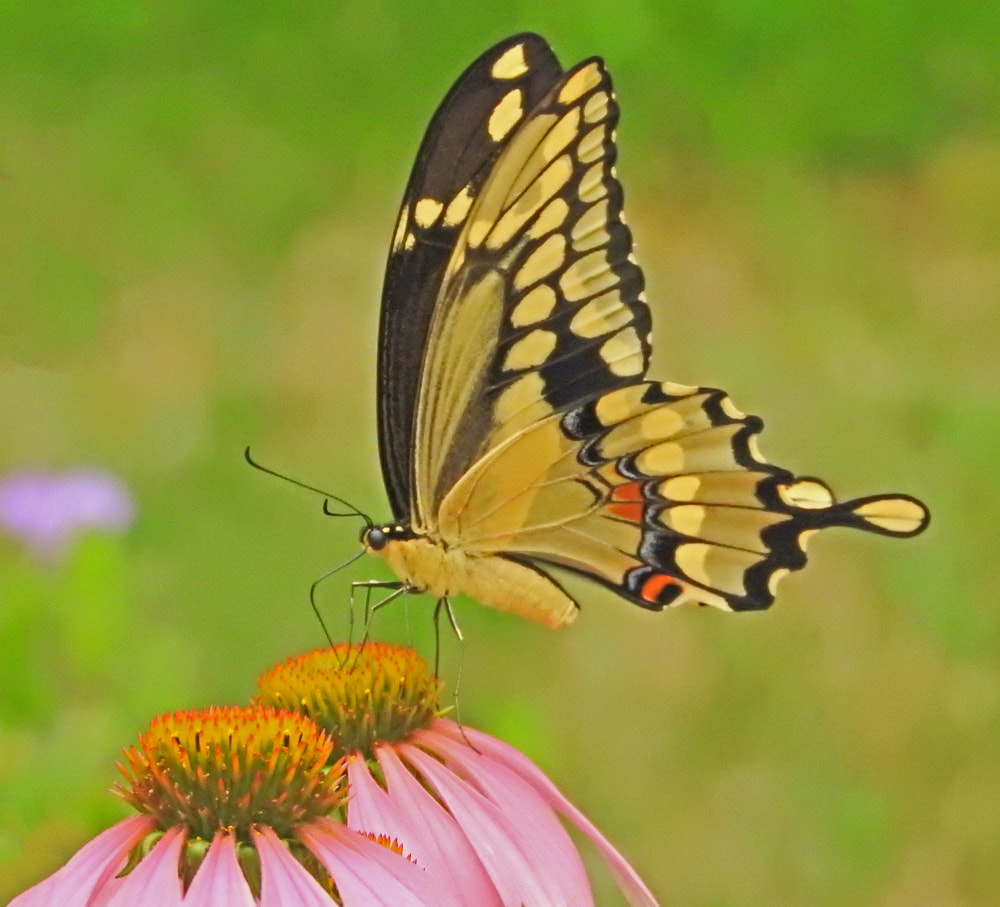








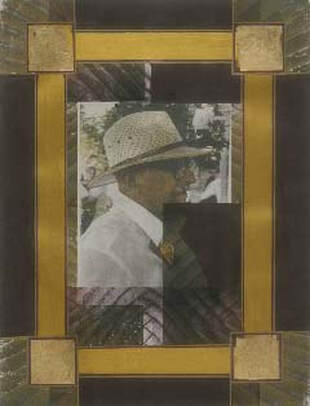






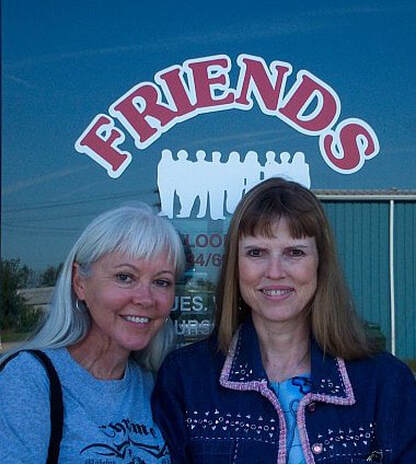











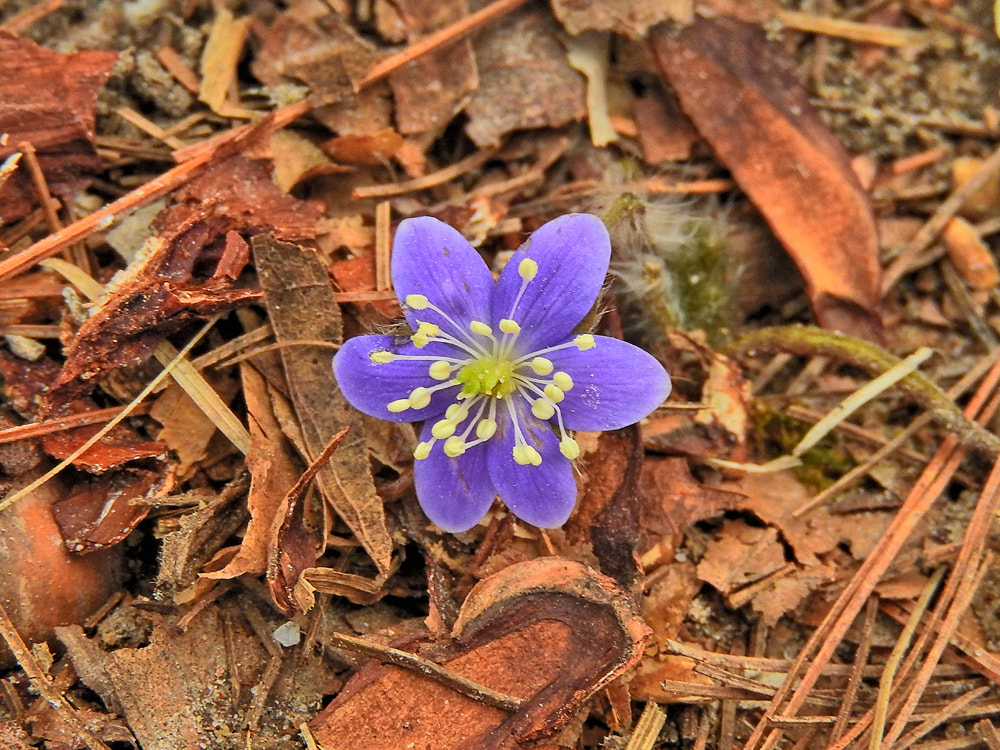




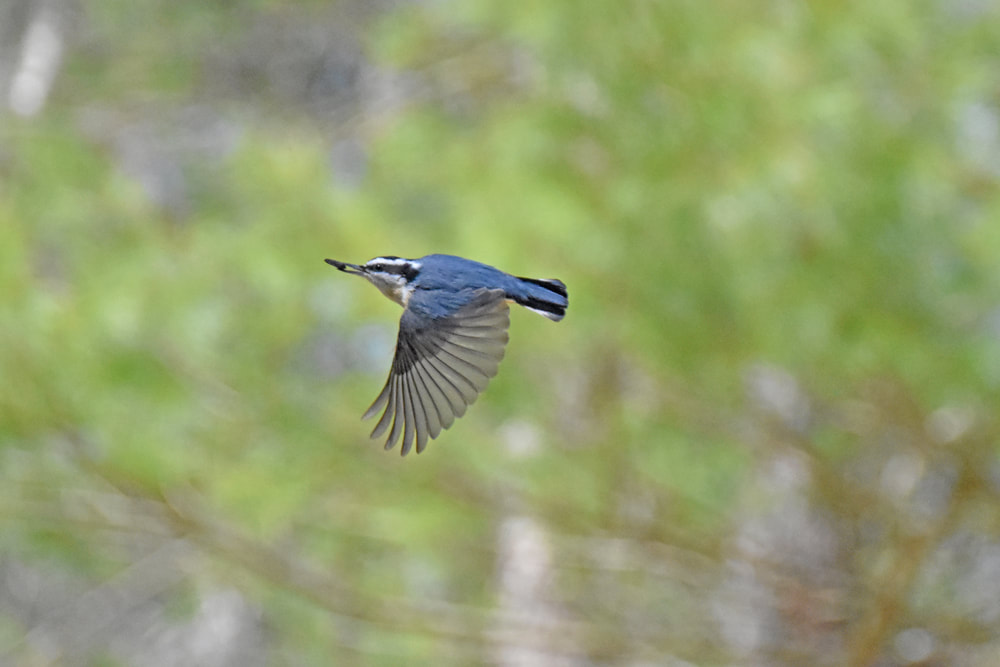
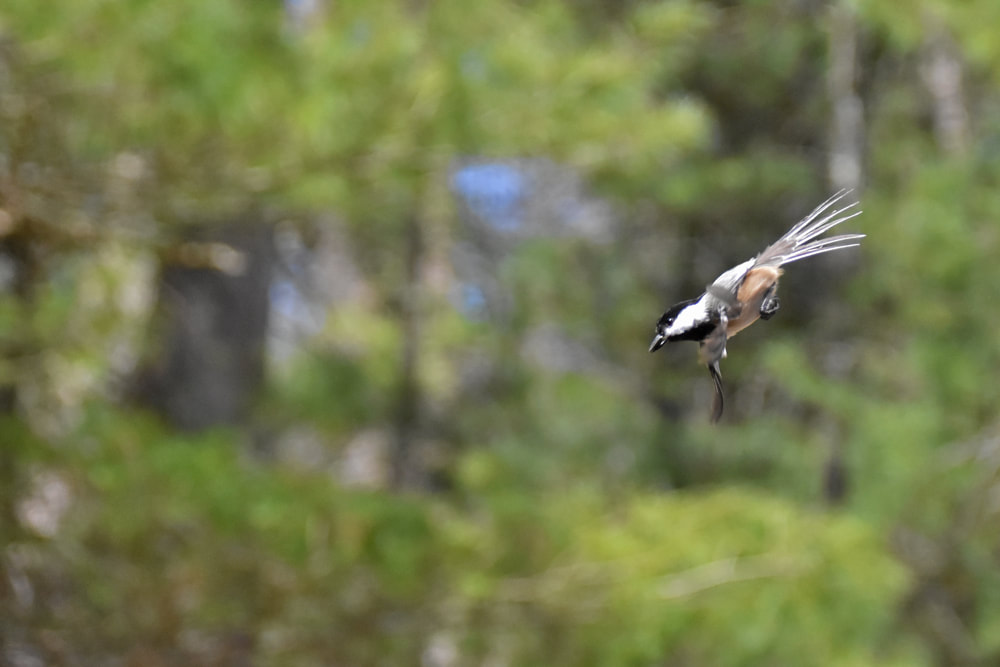
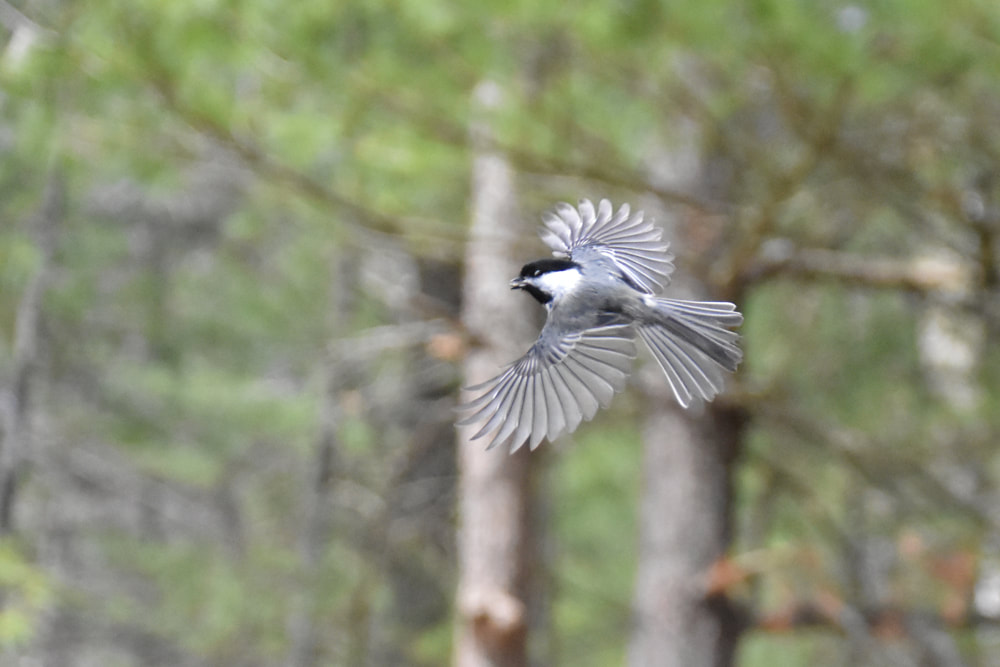

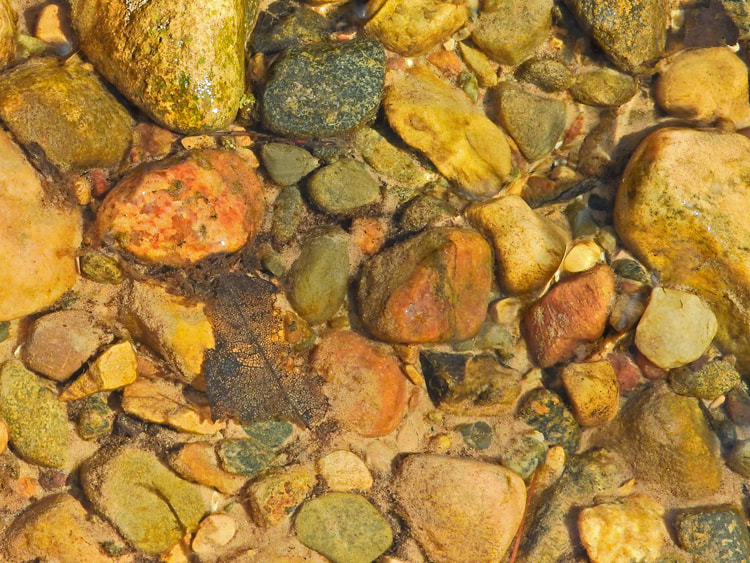
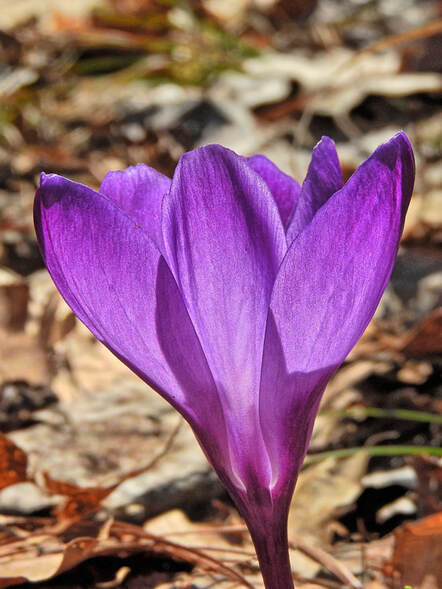







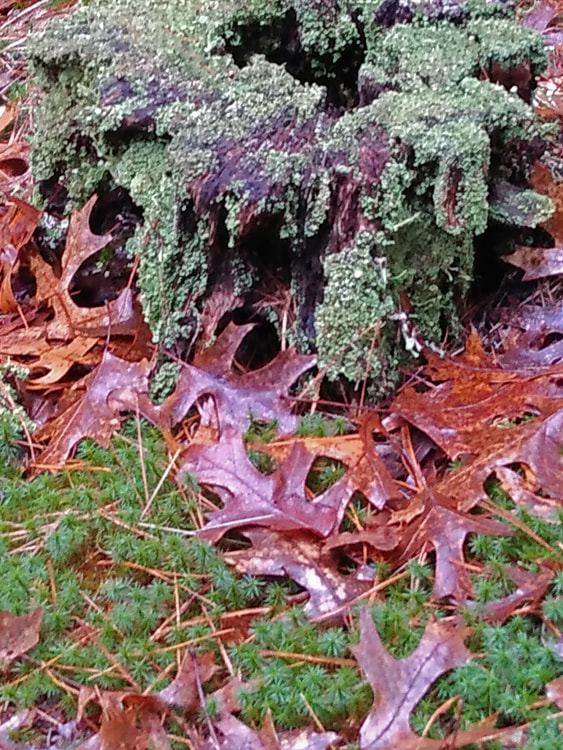



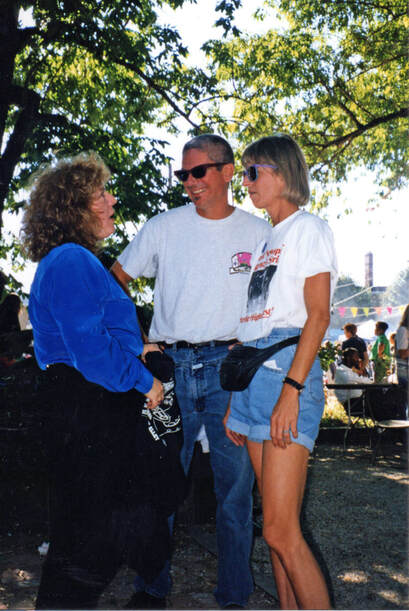













 RSS Feed
RSS Feed